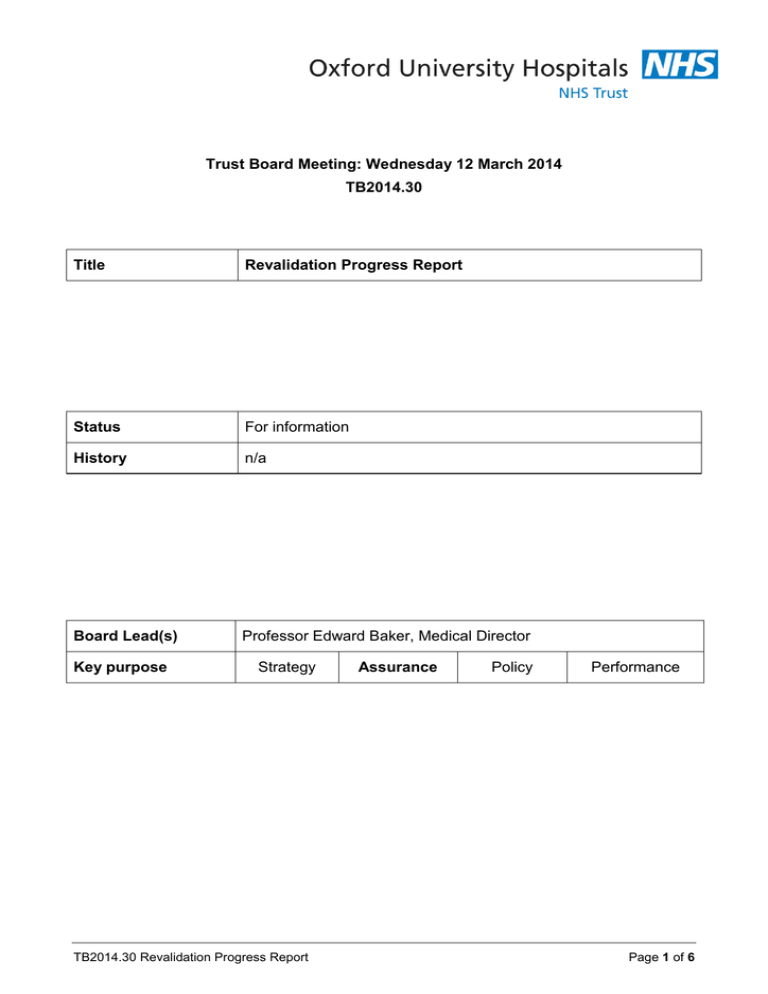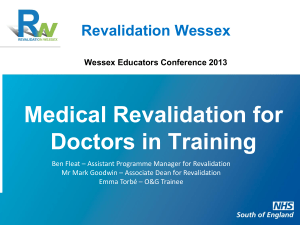Trust Board Meeting: Wednesday 12 March 2014 TB2014.30 Title
advertisement

Trust Board Meeting: Wednesday 12 March 2014 TB2014.30 Title Revalidation Progress Report Status For information History n/a Board Lead(s) Professor Edward Baker, Medical Director Key purpose Strategy TB2014.30 Revalidation Progress Report Assurance Policy Performance Page 1 of 6 Oxford University Hospitals TB2014.30 Executive Summary 1. Following the introduction of Medical Revalidation in December 2012, this report is provided to update the Board, towards the end of the first full year (2013-14) of implementation. 2. Recommendation The Trust Board is asked to note the contents of this report. TB2014.30 Revalidation Progress Report Page 2 of 6 Oxford University Hospitals TB2014.30 Revalidation Progress Report 1. Purpose 1.1. Following the introduction of Medical Revalidation in December 2012 this report is provided to update the Board as the first full year of the implementation phase comes to an end. 1.2. The paper will outline the scale of the process, performance metrics (including annual appraisal information) and detail next steps to be taken as the second year of the implementation phase commences. 2. Background 2.1. Medical revalidation was established to assure patients and the public that doctors are up to date and fit to practise. Revalidation involves the renewal, by the General Medical Council (GMC), of a doctor’s Licence to Practise. 2.2. Revalidation is a statutory obligation that all medical professional are required to engage with, and which the Trust is obliged to support. 2.3. Each doctor who holds a Licence to Practise must have a formal alignment, called a Prescribed Connection, with an organisation recognised by the GMC for revalidation purposes and called a Designated Body. 2.4. Designated Bodies include all NHS Trusts, NHS England, a variety of private healthcare providers and various other organisations (e.g. the Faculty of Public Health). Universities are not Designated Bodies and their medical employees must obtain Prescribed Connections through their honorary contract with a Designated Body. 2.5. The Board of each Designated Body must appoint a single senior doctor called the Responsible Officer (RO) who has a range of statutory responsibilities that include making a revalidation recommendation to the GMC, at the appropriate time for each doctor who has a Prescribed Connection. 2.6. The recommendation made by the RO is informed, in the main, by the outputs of annual appraisal, in which all doctors are required to engage. 3. Prescribed Connections 3.1. As above, every doctor with a Licence to Practise must have a Prescribed Connection. 3.2. The responsibility for creating a Prescribed Connection lies with the doctor rather than any employer or organisation with whom they are working. Even when a Prescribed Connection should exist by virtue of a contract between the Designated Body and the doctor, the connection itself can only be created by the doctor (via a simple online process on the GMC website). 3.3. The number of Prescribed Connections established with the Trust has risen dramatically since Revalidation became law in December 2012. On 30/9/2012 the Trust had 824 confirmed connections. This rose to 869 by 31/3/2013 and currently stands at 964 as of 3/3/2014. 3.4. The reason for this increase is primarily due to heightened awareness amongst doctors of the revalidation process and, in particular, of the need to create a Prescribed Connection. Some members of groups such as clinical academics and other honorary contract holders, non-substantive Trust employees including TB2014.30 Revalidation Progress Report Page 3 of 6 Oxford University Hospitals TB2014.30 Trust fellows, locums and zero hours contract holders have also proved slower to align themselves. This appears to have reflected confusions about when a Prescribed Connection should exist. 3.5. The Medical Director’s Office, in conjunction with HR, continues to work to identify those who have a contractual relationship with the Trust but who have yet to align themselves with a Designated Body. It is estimated that the number of doctors with a prescribed connection to the Trust will exceed 1,000 early in the new financial year, making OUH the second largest Designated Body in secondary care in England. 3.6. The work referred to above has highlighted the need for better information exchange between HR and the Medical Director’s Office around starters and leavers, and for previous appraisal and revalidation status to be reviewed as part of pre-employment checks. There has been significant progress on this matter, and the Medical Director’s Office now believes that almost all those who should have a Prescribed Connection with the Trust have been identified. 4. Revalidation Recommendations 4.1. For the financial year 2013/14 the Trust is due to make 170 recommendations. 4.2. As of 03/03/2014 164 recommendations have been made. The remaining 6 are due later in March. 4.3. Of the 164 recommendations made, 155 were positive and 9 involved a request for deferral. Of those 9 deferrals, none were for non-engagement or serious concerns but related to a lack of information provided due to long term sickness or maternity leave. 4.4. It should be noted that the Trust’s deferral rate is well below the national average and, to date, no second requests for deferrals have needed to be made. This puts the Trust in an excellent position in relation to similar organisations. 4.5. Of the 164 recommendations made to date the GMC have upheld the Responsible Officer’s decision in all cases. 5. Appraisals 5.1. An annual medical appraisal carried out by a trained appraiser is the main component of a doctor’s revalidation portfolio. 5.2. The Board received details of the Trust’s medical appraisal process and results for the 2012/13 appraisal round in the paper submitted in November 2013 in response to national concerns raised by Sir Bruce Keogh. The Trust was found to be performing well above the national average for appraisal rates for all groups of doctors. 5.3. The 2013/14 round of medical appraisals is currently in progress. As of 04/03/2014 the Medical Director’s Office is in receipt of 331 completed appraisals out of a total of 925 due, representing a 36% completion rate. This compares to a 25% completion rate (209 of 823 due) at the same point last year. 5.4. The Medical Director’s Office is tracking completion rates by Division and by individual appraiser and is confident that 100% of appraisals will be accounted TB2014.30 Revalidation Progress Report Page 4 of 6 Oxford University Hospitals TB2014.30 for by the time the window closes on 28th April 2014 (post-appraisal documentation must be submitted within four weeks of the appraisal meeting). 5.5. All appraisers have been asked to confirm their plans to complete all allocated appraisals by March 31st as required. 6. Next Steps 6.1. As highlighted above, the number of Prescribed Connections, and thus the number of appraisals and revalidation recommendations that need to be managed, continues to increase. It is anticipated that this rise will continue during the next 2 years of the implementation phase as all remaining doctors who should have a prescribed connection with the Trust establish one. In addition, the rate of recruitment of new doctors, principally consultants, far exceeds the rate of retirement or leaving for other reasons. 6.2. The progressive rise in numbers of doctors with a prescribed connection has implications. These include; 6.2.1. Medical appraiser capacity within the Trust must increase to manage the higher number of appraisals required. The Revalidation Support Team has recommended that each appraiser carry out 8-10 appraisals. New appraiser selection and training, over and above that needed to replace appraisers who choose to relinquish the role, will need to take place. 6.2.2. Alternatively or in addition, an increase in the PA provision per appraiser may be needed, to allow for the need to appraise those who join the organisation between appraisal windows but who have an imminent revalidation recommendation due and an incomplete portfolio. 6.2.3. The need to increase capacity for provision of GMC required information to individual doctors such as multi-source feedback services, performance metrics and reports on involvement in incidents and complaints. 6.2.4. The need for more administrative staff to support the processes, set out in more detail below. 6.3. It should be noted that the national implementation of revalidation called for 20% of the medical workforce to revalidate in the first year of the implementation phase. In the second and third years of the transition (at the end of which almost all doctors will have revalidated) the proportion is 40% in each year. For the year commencing 1st April 2014, the Trust will be responsible for making revalidation recommendations on 375 doctors. The impact of this much greater number includes: 6.3.1. A need to increase administrative support within the Medical Director’s Office. It will be necessary to prepare double the number of portfolios, each with 2 revalidation-ready appraisals rather than 1, for review by the Responsible Officer 6.3.2. A need for the Responsible Officer to devote substantially more time to the review of these portfolios and the making of recommendations. 6.3.3. A need for support to follow up on any issues identified as part of the process (e.g. if deferral or non-engagement recommendations are made). TB2014.30 Revalidation Progress Report Page 5 of 6 Oxford University Hospitals TB2014.30 6.4. As part of the on-going implementation phase, NHS England has drafted a Framework for Quality Assurance relating to revalidation. Whilst this is yet to be approved, it is a comprehensive and far reaching document designed to ensure similarity of standards and processes across all Designated Bodies. This is obviously to be welcomed but will increase the administrative, reporting and compliance functions associated with revalidation which will in turn require resourcing. 6.5. At present medical appraisal and revalidation is being managed from the Medical Director’s Office by 1 WTE Band 7 and 1 WTE Band 4 in addition to the time assigned to the Responsible Officer role within the Medical Director’s remit and the time assigned to the Deputy Medical Director to oversee the appraisal and revalidation processes. This may be insufficient moving forwards, and additional support will be the subject of a business case that will be considered by the Trust Management Executive in due course. 7. Recommendation The Board is asked to note the contents of this report. Professor Edward Baker Medical Director Report Prepared by: Dr Tony Berendt Deputy Medical Director March 2014 TB2014.30 Revalidation Progress Report Page 6 of 6








